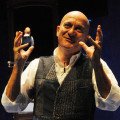The second act of the trilogy by Kronoteatro consistently takes the style of “Orfani”, dropping the reflection on the disintegration of the family in a mighty timeless dimension – A review by Renato Palazzi
The same features of Orfani, by and large, are found in the second act – Pater familias_dentro le mura – of what actually appears as a true trilogy, with its continuity, its consistency of style, its overall broad design: again there is a reminder of the classic age, which in this case consists in the constant references to the image of the Minotaur and the labyrinth, however, fell into a state of brutal actuality, the violence of the pack, the blind impulses of bullying. Here, too, the overall system is based on a strong physical aggression in bestial, an end in itself, which excludes any thought or feeling.
If in Orfani the figure of the father-master was ominously imperious and dominant, in Pater familias he is ruthless cruelty murdered by his son and his companions, that generation of young people we saw at the end of the first show, already educated to war. The father who tries in vain to hold on to the values of fatigue and manual work, appears defeated at the start, a loser, as they say, bound to the role of sacrificial victim: in the heart of the labyrinth that he, more or less, had build in his imagination, a place of dark fantasies, where he yearned to take the form of a mighty Minotaur able to reduce the son Theseus at his mercy. On the contrary, the latter, backed by his fellows, will kill him with an hatchet, like a bull led to the slaughter.
The idea of a mental labyrinth, an oppressive architecture of floors and walls that expand and contract around the human figures that are all in – perpetrators and victims – all imprisoned, it is also the backbone of this construction, made of a series of dark worn wooden tables, that on a face reveal emblematic mirrors. For every next scene the tables are moved, recombined in countless figures: leaning on each other, next to each other, arranged in vertical or horizontal, superimposed or juxtaposed, they form narrow paths and stuffy cubicles. Suddenly reversed to the ground noisily, cause threat feelings in the spectators.
How Orfani, also Pater familias – which is a couple of years later – seems to present the stylistic elements that refer to theatrical codes not entirely belonging to our present time, albeit to a lesser extent than in the previous show. But, as mentioned, the inclusion of the two pieces in a single path offer other interpretations, almost dropping them in an extra- time dimension, strictly bound to the internal project of the group. So the project itself hits for that high and mighty and not reassuring capturing you, more than the advantages and limitations of each single show.
Pater familias_dentro le mura (Pater familias_inside the walls)
dramaturgy: Fiammetta Carena
director: Maurizio Sguotti
movements: Davide Frangioni
with: Tommaso Bianco, Alberto Costa, Vittorio Gerosa, Alex Nesti, Nicolò Puppo, Maurizio Sguotti

















